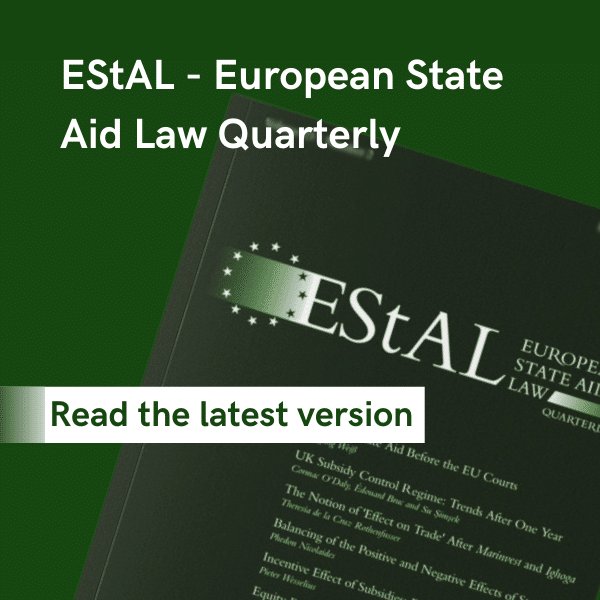
Public funding of assets which are used exclusively by certain undertakings constitutes State aid. If the state chooses to fund certain assets or activities, then it must do so consistently in all regions and in relation to all affected undertakings.
Introduction
A typical mission of the state is to provide public goods. Normally public funding of public goods is not State aid because they are non-economic. However, when goods which are normally non-economic are linked to infrastructure and services which are exploited commercially they may be subject to State aid rules. Sometimes there is no clear dividing line between what is economic and what is not. In this connection, two recent Commission decisions provide useful guidance on where the line should be drawn between economic and non-economic infrastructure.
Commission decision SA.42538[1] concerning dredging of the port of Ventspils in Latvia and Commission decision SA.40433[2] concerning the upgrading of the airport of Kaernten in Austria appear to be typical cases of public funding of investment in a medium-sized port and a regional airport, respectively. The port and the airport are not really significant market players. However, the analysis of the need for aid in these two decisions is very significant and in fact raises a serious question as to the usefulness of the funding gap method when there are options which are not captured by the funding gap calculations.
The investment projects
In the case of Latvia, the project concerned dredging inside the port so that it could accommodate large “Panamax” vessels. Otherwise, other ports would be preferred by shipping lines and Ventspils would decline. The total investment cost was EUR 4 million which would be financed by a contribution of EUR 3.4 million from the EU cohesion fund and EUR 0.6 million from the port itself.
The money from the cohesion fund was, of course, State aid which was shown to be necessary because the net present value of the project resulted in a negative value of EUR 3.8 million. That is, there was a funding gap. Since the amount of aid [EUR 3.4 million] was less than the funding gap, the Commission concluded that the aid was necessary and proportional.
In the case of Austria, the project aimed to prevent further decline and eventual closure of the airport. The total investment costs for the upgrading were EUR 24.3 million. The public funds that were contributed amounted to EUR 15 million. A funding gap exercise showed that over the 20-year lifetime of the investment the discounted cash flows were a negative amount of EUR 14.9 million. The amount of aid then appears to exceed the funding gap. However, the aid was assessed on the basis of the 2014 aviation guidelines which allow aid up to 75% of the investment costs. In this case the aid intensity was 61.7% [= 15/24.3].
So, apparently in both cases aid was indispensable to prevent the decline of the port and the airport, respectively. However, before examining in more detail the funding gap calculations in these two cases it is instructive to review the assessment of the Commission on whether each project financed economic infrastructure or not.
The boundary between public and private infrastructure
Ventspils port
In paragraph 34 of its decision, the Commission observed that “as regards dredging, […] such works can be undertaken to meet a number of different objectives. In this case, insofar as dredging is directly related to the development of the commercially exploited infrastructure, the carrying out of such works cannot be considered as falling within the public policy remit. In particular, in this case dredging appears indissociably linked, by its nature and purpose, with the cargo transport activity, which is a commercial activity. As stated by the Latvian authorities, dredging is clearly aimed at preventing a further decline of the market share of the port. Consequently, the public financing of the planned dredging relates to the economic activities of the VFPA, which will be able to remain on the market of transhipment services in the East coast of the Baltic Sea, where it operates.” Footnote 7 which is attached to this paragraph refers to these three cases as providing useful guidance: “See e.g. Commission Decision of 11 March 2014 in case SA. 35720 ( United Kingdom) Liverpool City Council Cruise Liner Terminal, OJ C 120, 23.04.2014, p. 4, where dredging was considered as public works aimed at maintaining access to maritime routes for the benefit of the maritime community as a whole, in the interest of the general public; see also Commission decision of 27 March 2014 in case SA.38302 (Italy) Investment Aid to the Port of Salerno, OJ C 156, 23.05.2014, p. 10, where the objective was instead to develop a dock that was to be commercially exploited.”
Kaernten airport
The Austrian authorities claimed that certain parts of the project were not economic because they were linked to the exercise of official authority. The Commission distinguished between the different parts of the infrastructure as follows. “(38) The Airport’s infrastructure and equipment are owned and operated by KFBG, the recipient of the notified public funding. Firstly, KFBG charges fees for the use of these infrastructures, and thus exploits the airport commercially. […] The envisaged public funding for the refurbishment of the runway and the modernisation of equipment and infrastructure such as de-icing and apron sweeping gear, approach lighting, runway marking and buildings will allow the airports to continue operating with improved safety. The costs of the improvement of the safety of airport operations however correspond to normal costs of an economic activity that cannot be considered to fall within the public policy remit. It follows that KFBG, the entity exploiting the infrastructure in question, is an undertaking for the purposes of Article 107(1) of the TFEU.”
Do you know we also publish a journal on State aid?

The European State Aid Law Quarterly is available online and in print, and our subscribers benefit from a reduced price for our events.
“(39) The Court of Justice has held that activities that normally fall under a State’s responsibility in the exercise of its official powers as a public authority are not of an economic nature and do not fall within the scope of the rules on State aid. Such activities may include, for example, security, air traffic control, police, customs, etc. The financing has to be strictly limited to compensation of the costs to which they give rise and may not be used instead to fund other economic activities.”
“(40) However, public financing of non-economic activities necessarily linked to the carrying out of an economic activity must not lead to undue discrimination between airport managers. Indeed, it is established case law that there is an advantage when public authorities relieve undertakings of the costs inherent to their economic activities. Therefore, when it is normal under a given legal order that civil airports have to bear certain costs inherent to their operation, whereas whether or not those costs relate to an activity which in general is considered to be of a non-economic nature.”
“(41) The Austrian authorities provided a list of the activities that are in general considered as non-economic that Austrian airports are obliged to carry out, pursuant to Austrian law: Providing security (surface areas, premises, control equipment; firefighting; provision of premises for air traffic control.”
“(42) The information provided by the Austrian authorities however did not show that the public financing of those activities that are necessarily linked to the carrying out of an economic activity does not lead to any discrimination between airport operators in Austria. In fact, the available information rather indicates that Austrian airports normally have to bear the costs of the equipment and premises mentioned above and that the public investment support in question relieves Kärnten Airport from part of these costs.”
The points made above by the Commission lead to four conclusions. First, it does not matter whether an undertaking invests in the improvement of the safety of its operations in the interest of its customers. As long as these improvements are directly linked to its operations, then any public funding of such investments would confer to it an advantage and would constitute State aid.
Second, the state may decide that certain parts of airport operations can be paid directly by the state without such a payment constituting State aid when these operations are not economic in nature. For example, street lighting is normally paid by the state. Therefore, if the state pays for the lighting on a toll road.
Third, when the state pays for the non-economic activities which are linked to economic ones, all operators must be treated equally. For example, if the state pays for street lighting, then all operators of toll roads should be relieved of this expense. There is a State aid problem if some toll road operators bear these costs while others do not.
Fourth, there is nothing preventing a Member State from deciding that while street lighting is supplied for free by the state, operators of toll roads would nonetheless pay for these costs.
In addition to the four lessons that can be drawn from this case, there is one more issue that deserves attention. In paragraph 39 the Commission correctly states that if something is linked to the operations of an undertaking, then the costs should be borne by that undertaking. But an activity involves exercise of official powers, such as customs checks, then the costs can be fully covered by the state. It is important to note that in paragraph 40 the Commission does not refer to such things as firefighting. By contrast, it refers to firefighting in paragraph 41. But firefighting is something which is integral in the safe operation of an airport. Even if firefighting in general is a public good, it ceases to be a public good when it is necessary for the provision of an economic service such as air travel. Then the logic of paragraph 39 should apply. This is also the logic of paragraph 34 of the decision on Ventspils port. Dredging outside ports is a public good, while dredging inside ports is a private good that should be paid by the port operator and users. The same can be said about air traffic control by the tower of the airport. Directing aircraft that overfly a country is a public good, but guiding them in their approach to a specific airport is a private good that should be paid by the airport operator. Although, the Commission is certainly right in insisting that the state should be consistent in its treatment of the various non-economic activities across operators, it is difficult to understand why it does not simply apply the logic of paragraphs 34 and 39 and determine when an activity turns from non-economic to economic.
The limits of the funding gap method
Both the Latvian and the Austrian case rely on the funding gap analysis to show the necessity and proportionality of aid. In the case of Latvia, State aid of EUR 3.4 million was necessary to cover a funding gap whose NPV was EUR 3.8 million. The port would inject EUR 0.6 million. In the case of Austria, the amount of State aid was EUR 15 million. The funding gap was EUR 14.9 million, while the aid intensity was 61.7%, as the total eligible costs were EUR 24.3 million.
The Latvian project was necessary because otherwise the port would lose customers. Large vessels would go elsewhere. Because the aim of the project was to retain customers, there was no increase in net income. The discounted net revenue was zero (0). This raises the question why the port would invest even EUR 0.6 million if it would get back zero? This appears to lack economic logic. A possible answer is that without the investment, there would be a reduction in revenue. So, from the perspective of the port, it could possibly make sense to invest EUR 0.6 million to avoid an even larger loss. But then, if the project in reality aimed to prevent future loss of income, then the funding gap method provides the wrong analytical approach. This is because the funding gap calculation does not take into account the counterfactual: what the port would have done without the aid. The funding gap method is the correct approach when there is no counterfactual and in case port chooses not to invest nothing happens to it. But when a counterfactual exists and the counterfactual is a declining state of operations, the port has at least another choice: to close down.
To see why this is so, consider the following example. Assume a project requires investment of 100 and generates net revenue of 0. Then the funding gap is –100 [= –100 + 0]. Now assume that, if the investment does not take place, there is a drop in net revenue of 20 over the life of the asset [e.g. a port]. Now the funding gap is – 20 [= – 0 + (– 20)]. This means the operator should be willing to pay at least 20 to avoid the loss. The difference between the two situations is – 80 [= – 100 – (– 20)]. The true funding gap is only 80 which means that, first, it is meaningless to focus exclusively on the numbers produced by funding gap analysis when the counterfactual exists. Second, the operator would have invested at least 19.9 to avoid a loss of 20. Third, a rational operator would not even have committed 20 of its own money, if the closure of the port would have been a cheaper option.
Then, of course, the state could intervene to provide aid in order to keep the port open. But in that situation the calculation of the necessary amount of aid would lead to different results. If closure of the port were not an option, the amount of aid that would be necessary would not be 100 but only 80. If closure were a feasible option, say because the cost of closure for the operator would be only 10 [instead of incurring a loss 20 over the life of the port], and if the necessary investment that could ensure the continued operation of the port would still be 100, then the minimum aid necessary would be only 90, instead of 100.
The same reasoning can be applied to the use of the funding gap method in the case of the Austrian airport. There too the aid was intended to prevent the decline of the airport. In that case too there is no apparent consideration, at least in the Commission decision, that the impact of a counterfactual was taken into account. In fact, the assessment here is more questionable because it was based on the new aviation guidelines that do refer to counterfactuals. It is striking that in paragraph 72 of the decision, the Commission observes that “without the necessary financing to refurbish the runway, the airport would inevitably face closure” and then goes on in paragraph 80 to explain that “point 99 of the Guidelines stipulates that in cases where no specific counterfactual is known, in order to be proportionate, the amount of the aid should not exceed the capital cost funding gap of the investment project.” But there is a counterfactual. It is the inevitable closure.
Conclusions
These two apparently routine cases provide valuable guidance on where the line should be drawn between the economic and non-economic infrastructure. However, they also raise disturbing questions about the appropriateness of the funding gap method when the aid recipients face other options which are not factored in the calculations.
——————————————————————————–
[1] The full text of the Commission decision can be accessed at:
http://ec.europa.eu/competition/elojade/isef/case_details.cfm?proc_code=3_SA_42538.
[2] The full text of the Commission decision can be accessed at:
http://ec.europa.eu/competition/state_aid/cases/258091/258091_1710939_186_2.pdf.



